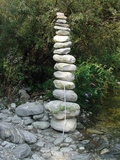Rock balancing
Appearance

Rock balancing is an art, discipline, or hobby depending upon the intent of the practitioner, in which rocks are balanced on top of one another in various positions.
Modes of rock balancing
[edit]Rock balancing can be a performance art, a spectacle, or a devotion, depending upon the interpretation by its audience. Essentially, it involves placing some combination of rock or stone in arrangements which require patience and sensitivity to generate, and which appear to be physically impossible while actually being only highly improbable. The rock balancer may work for free or for pay, as an individual or in a group, and their intents and the audiences' interpretations may vary given the situation or the venue.
Styles of rock balancing
[edit]- Pure Balance - each rock in near-point balance
- Counter Balance - lower rocks depend on the weight of upper rocks to maintain balance
- Balanced Stacking - rocks lain flat upon each other to great height
- Free Style - mixture of the two above; may include arches and sandstone.
-
Style Balanced Stacking
-
Pure Balance
-
Free Style Balance
Notable rock balance artists
[edit]- Bill Dan, a San Francisco immigrant artist who is helping popularize the art in the U.S. (and around the world).
- Andy Goldsworthy, an influential artist working in the field, for whom rock balancing is a minor subset of his "Collaborations With Nature".
- Dave Gorman, British TV and radio comedian took up rock balancing after meeting Bill Dan in San Francisco.
- Mark Mason, a Sarasota, Florida based rock balance artist that travels the globe creating ephemeral art.
References
[edit]- "Rock Balancing is both art and advocacy". By Reuters . Philippines. August 2011.
- "The Art of Rock Balancing". By Jeff Zapanta. Philippines. May 2011.
- "Care-join-different-kind-rock-group". By KC Santos. Philippines. April 2011.
- "Rock-balancing-promotes-environmentalism". By KC Santos. Philippines. April 2011.
- "Stuart Finch - Rock Balancing Act". By Sarah Phelan. Metro Santa Cruz. March 2001.
- "Lila Higgins' gravity-defying cairns become ephemeral art at Riverside's Division 9 Gallery". The Press-Enterprise. July 21, 2008.
- "Rock mystery solved". By Sven Herselman. 29 May 2008.
- "OK, really, how does he do it?" By David Holmstrom. The Christian Science Monitor. December 02, 1999.
- "It’s Not Easy Picking a Path to Enlightenment". By Andy Newman. New York Times. July 3, 2008.
- "Man sets 'em up, physics does the rest". By Gary Warth North. (San Diego) County Times. September 29, 1996.
- "Partners' Beach Works Strike a Balance Between Art, Nature". By Len Hall. Los Angeles Times. November 18, 1994.
- "Gilles Charrot - L'homme qui murmure a l'oreille des pierres" Martine Schnoering. September 15, 2009.



